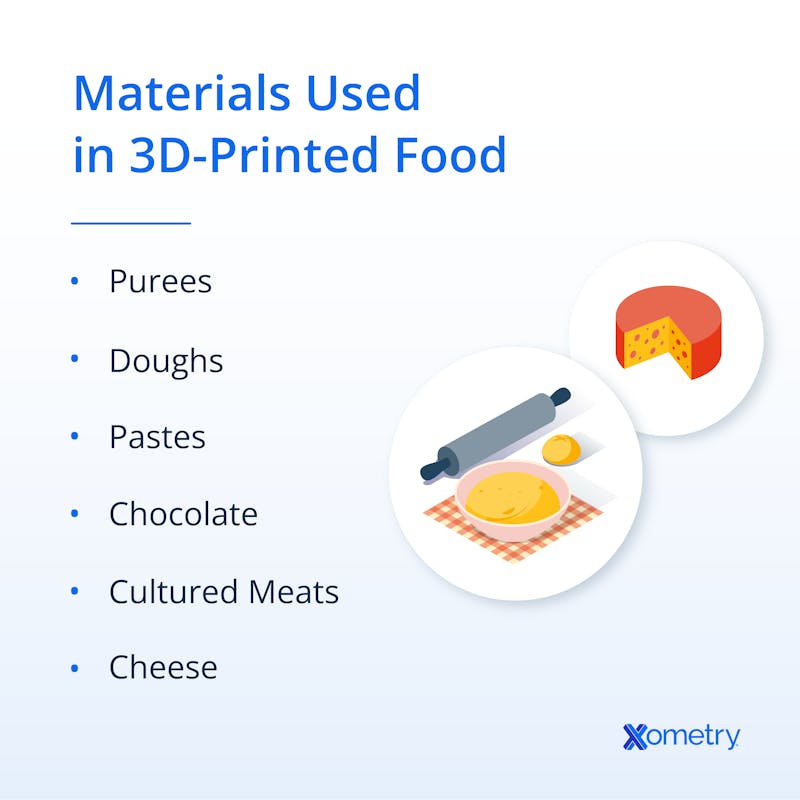The concept of 3D-printed foods is as intriguing as it is incredibly innovative. Blending advanced technology with culinary art, chefs and restaurateurs everywhere are excited at the prospects that 3D-printed food has to offer. Food made with a 3D printer tastes just like regular food because it’s made with regular, edible ingredients. The difference with this type of food is not in the taste, but in its texture and how it looks. Chefs can let their creativity shine and make unique and visually stunning foods, which will thrill customers by engaging their senses and elevating the overall dining experience.
Note: While here at Xometry we don’t yet offer 3D-printed food services, we did help to make parts for the first-ever commercial 3D chocolate printer, created by entrepreneur Ellie Weinstein. All the details on this venture can be found in the below video:
We are also closely monitoring the progress in this interesting space and will keep you updated on any developments. In the meantime, here’s a look at the history of 3D-printed foods, how they are made, and their pros and cons.
What Is 3D Printed Food?
3D-printed food refers to edible items created using 3D printing technology. By applying the principles of additive manufacturing, food ingredients are layered to produce shapes and structures that might be challenging to achieve with traditional cooking methods. Additionally, 3D-printed food enables personalized nutrition and efficient use of ingredients.
A Brief History of 3D Printed Food
The first foods were 3D printed in 2006 by a team of researchers at Cornell University’s Mechanical and Aerospace Engineering Department. The foods in question were chocolate, cookie dough, and cheese. The team developed an open-source, multi-material 3D printer called the Fab@Home that used precise extrusion syringes. Since then, a whole host of ingredients have been tested in various forms. These include purees (mashed potatoes and beans, hummus, applesauce), pastes (butter, icing, tomato, bean), and cultured meats (vegan meats, fat cells).
3D-Printed Foods Today
Beyond the ability to make foods with difficult shapes and intricate details that would be a major hassle to make by hand, this technology can also make foods that cater to personal nutrition needs, whether it’s food allergies, intolerances, or preferences. It can make dishes for those on vegan, gluten-free, or dairy-free diets, and help them make healthier choices when dining out and options for particular diets are limited. Foods can be personalized with names or other customizations and even make a bespoke consistency for ultimate customer satisfaction. This can prove particularly useful for children who are sensitive to certain food textures and could help broaden their notoriously limited food palate.
The 3D-printed food method is quick, reduces prep time, makes efficient use of ingredients, and minimizes food waste (and, in turn, food scarcity and global food shortages) as it only uses the exact amounts needed. In addition, it keeps costs down for businesses and helps the fight toward sustainability. Another way it can help a food business is by producing the exact same product every single time—top chefs have been known to toss a plate of perfectly edible food in the trash because it doesn’t look as uniform as the others.
Because it’s not yet mainstream, public perception and acceptance of 3D-printed foods isn’t as high as you’d think. People are weary of the role of technology in food prep and may question the food’s authenticity, quality, or the proper sanitization of the machinery. There’s also not a large array of ingredients compatible with 3D printers (yet!), and its current speed and scale might not meet the demands of busy restaurants or food services. In addition, the initial investment in one of these printers is quite high (and let’s not forget about maintenance) so smaller businesses might struggle to jump on the bandwagon. Workers will also need adequate training on how to use the machines. There are also the issues of hygiene, safety, and regulation, which haven’t been ironed out yet.
How Does 3D Printed Food Work?
3D printing food works in the same way as ordinary additive manufacturing, particularly fused deposition modeling: by building the product—in this case, the food—one layer at a time. But before that, a digital CAD (computer-aided design) file must be made. The file has the exact instructions, including consistency, shape, size, and any other details that the printer will follow to make the food. The ingredients have to be blended or processed into a compatible consistency so that they can be extruded onto the build platform through the printer’s nozzle, just like filament would. They’re then loaded into the printer, and the CAD file is transferred to the printer so that it can start printing.
Just before technicians hit “print,” they’ll make sure the settings (like parameters, temperature, and extrusion speed) are where they should be. There’s not much manual effort needed once the machine starts printing, other than monitoring. Depending on what you’re making, there might be some post-processing required. For instance, cookie dough, which is extruded as a paste, will need baking after printing. Since they’re extruded in liquid form, chocolate and cheese need to solidify before being taken off the plate. Thankfully, they both tend to cool rather quickly. Other items might need some finishing touches, like glazing or garnishing.
What Materials Are Used in 3D Printed Food?
Materials used in 3D-printed food are extruded through a printer nozzle and are often prepared by blending or processing traditional food items into a consistency suitable for printing. The different materials used in 3D-printed food are shown below:

What Does 3D Printed Food Taste Like?
The taste of 3D-printed food largely depends on the ingredients used. Since the raw materials are traditional food items, the taste can be comparable to non-printed versions, with the primary difference being in texture and presentation.
Is It Safe To Eat 3D Printed Food?
Yes, 3D-printed food is safe to eat so long as the ingredients are handled and processed hygienically, and the printer components are food-safe. Regulatory agencies in various countries are beginning to set guidelines to ensure the safety of 3D-printed food items.
What Is the Advantage of 3D Printed Food?
There are many advantages of 3D printed food—from being quicker and easier than traditional food-preparation methods, to being a more-healthy option, to less food waste. The advantages of 3D-printed food are listed and described below:
1. Aids in Creating Elaborate and Imaginative Meal Designs
3D printing food allows chefs and food creators to unleash their creativity and introduce visually stunning and intricate designs that captivate diners. This improves the dining experience by offering unique and personalized presentations that would be difficult to achieve through traditional methods.
2. Waste Reduction Achieved by Using Ingredients Effectively
By utilizing precise amounts of ingredients, 3D printing minimizes food waste. This efficiency not only reduces costs for businesses but also contributes to environmental sustainability by conserving resources and minimizing landfill waste.
3. Improved Structure and Texture Consistency
Consistency in structure and texture is important, especially in commercial food production in which uniformity is key to customer satisfaction. 3D printing ensures that each food item meets the desired specifications consistently.
4. Possibility of Mitigating Food Scarcity
With the ability to utilize alternative ingredients such as plant-based proteins, 3D-printed food offers a promising solution to food scarcity. 3D printing has the potential to address global food shortages and reduce dependence on traditional farming practices.
5. Substitutes for Particular Dietary Requirements or Limitations
Customizable food options cater to individuals with specific dietary needs or restrictions, such as gluten-free or vegan diets. This inclusivity not only enhances accessibility to nutritious meals but also empowers individuals to make healthier choices that align with their dietary preferences or requirements.
6. Participation in Initiatives for Sustainability
3D printing food in-house supports broader sustainability initiatives by reducing food-transport requirements and lessening the need for resource-intensive ingredients. 3D printing food aligns with the growing demand for environmentally conscious practices within the food industry.
7. Inventive Presentation of Food
The visual aspect of dining is as important as taste, especially in high-end dining experiences. 3D-printed food allows for innovative and captivating presentations that engage diners on a sensory level, elevating the overall dining experience and fostering appreciation for culinary artistry.
What Is the Disadvantage of 3D Printed Food?
Despite its many advantages, 3D printing food also has its disadvantages. The disadvantages of 3D-printed food are listed below:
- Limited Speed and Scale of Production: The current speed and scale of 3D-printed food production may not meet the demands of all types of food-service environments, which may limit its practical application in high-volume settings.
- High Initial Cost: The initial investment required for acquiring 3D food printers can incur high initial costs. For smaller businesses or individuals, this may be a barrier to adoption. Additionally, ongoing maintenance costs may further contribute to the overall expense.
- Specialized Training Requirement: Operating 3D food printers effectively requires users to have specialized training and expertise. This could lead to challenges in finding personnel capable of managing the equipment and optimizing production processes.
- Limited Material Options: While a variety of edible materials can be used in 3D printing, the range may still be limited compared to the materials and ingredients associated with traditional cooking methods. This limitation could restrict the diversity of dishes that can be created using this technology.
- Regulatory and Safety Concerns: There are regulatory and safety concerns regarding the use of 3D-printed food, particularly as it relates to the sourcing and handling of ingredients. Additionally, hygiene and sanitation of the printing process may be called into question.
- Perception and Acceptance: Despite its potential benefits, 3D-printed food may face challenges in gaining widespread consumer acceptance due to perceptions about food quality, authenticity, and the role of technology in food preparation. Overcoming these perceptions could require significant marketing and education efforts. Additionally, cultural 3D-printed food may negatively impact traditional culinary practices and cultural food heritage which could lead to concerns about the loss of culinary diversity and authenticity.
What Type of 3D Printing Is Used for 3D Printed Food?
The most common type used for 3D-printed food is fused deposition modeling (FDM), in which material is extruded through a nozzle to build food items layer by layer. Other types of 3D printing used for food include selective laser sintering (SLS) for binding powdery ingredients with a laser and binder jetting for combining powdered materials with a liquid binder.
What Are the Different Applications of 3D Printing Aside from 3D Printing Food?
Since the start of the 21st century, 3D printing has emerged as a viable alternative to traditional manufacturing methods and as a solution to fabricating parts whenever traditional methods are limited. It's also pivotal in prototyping across industries, enabling rapid iteration and testing of new designs. Beyond food, 3D printing has diverse applications, including the creation of: medical implants, aerospace components, automotive parts, machine and hardware components, and custom fashion items.
How Xometry Can Help
While we don’t yet offer 3D food services, we do make a host of 3D-printed food-safe products. We also have a wide range of other manufacturing capabilities for all of your prototyping and production needs. Learn more about our custom online 3D printing service and get your instant quote today.
Disclaimer
The content appearing on this webpage is for informational purposes only. Xometry makes no representation or warranty of any kind, be it expressed or implied, as to the accuracy, completeness, or validity of the information. Any performance parameters, geometric tolerances, specific design features, quality and types of materials, or processes should not be inferred to represent what will be delivered by third-party suppliers or manufacturers through Xometry’s network. Buyers seeking quotes for parts are responsible for defining the specific requirements for those parts. Please refer to our terms and conditions for more information.


